Spatiotemporal Variation of Snow Depth in the Northern Hemisphere from 1992 to 2016
Abstract
1. Introduction
2. Datasets
2.1. Passive Microwave Data
2.2. Ground-Based Data
2.3. Topographic and Land Cover Data
2.4. Snow Cover Datasets
3. Methods
3.1. Theoretical Basis
3.2. Processing Flow Overview
3.3. Analysis Index Description
4. Results
4.1. Validation of Snow Depth Dataset
4.2. Variation of Snow Depth
4.3. Snow Cover Days
5. Discussion
6. Conclusions
Author Contributions
Funding
Acknowledgments
Conflicts of Interest
Appendix A
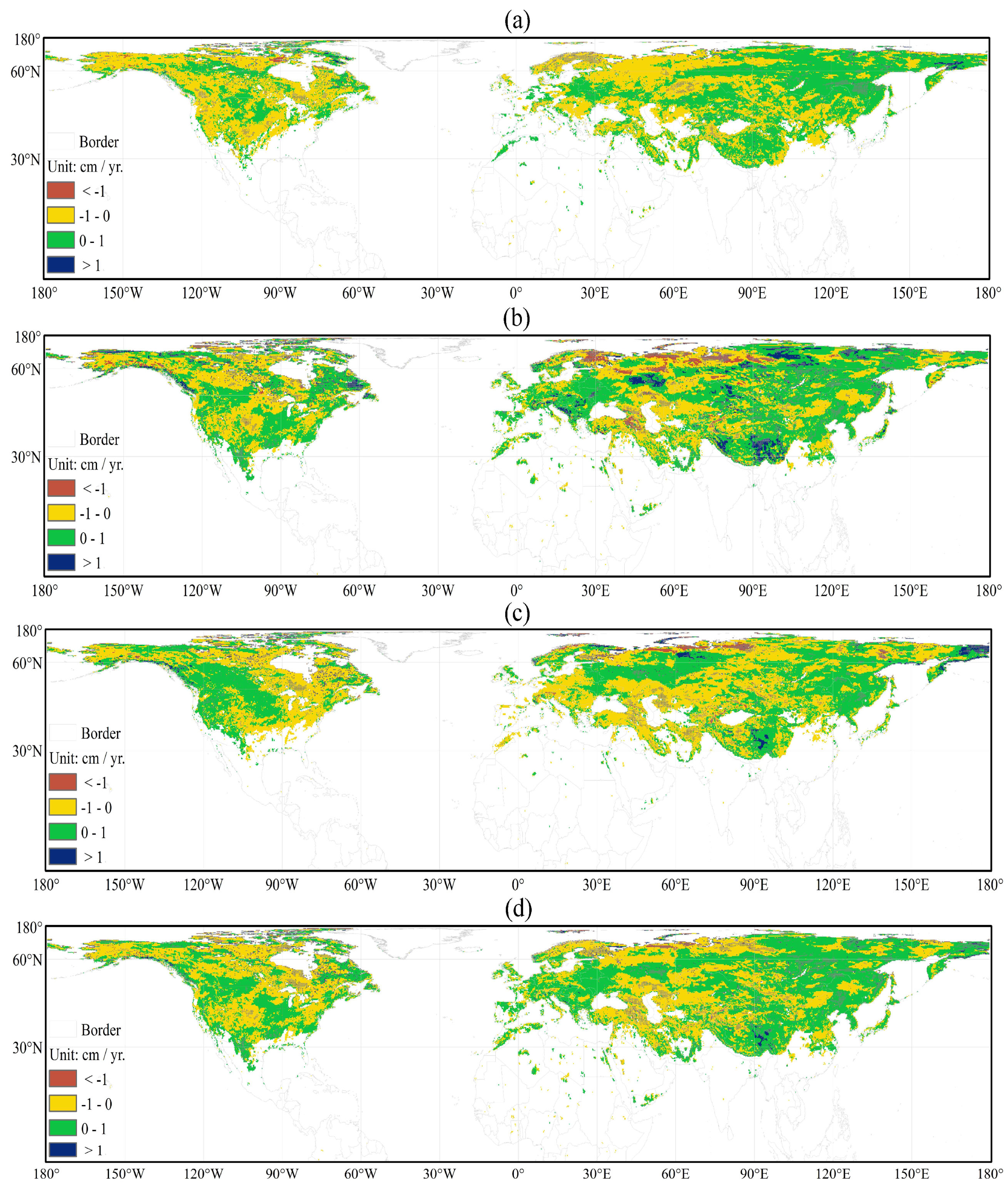
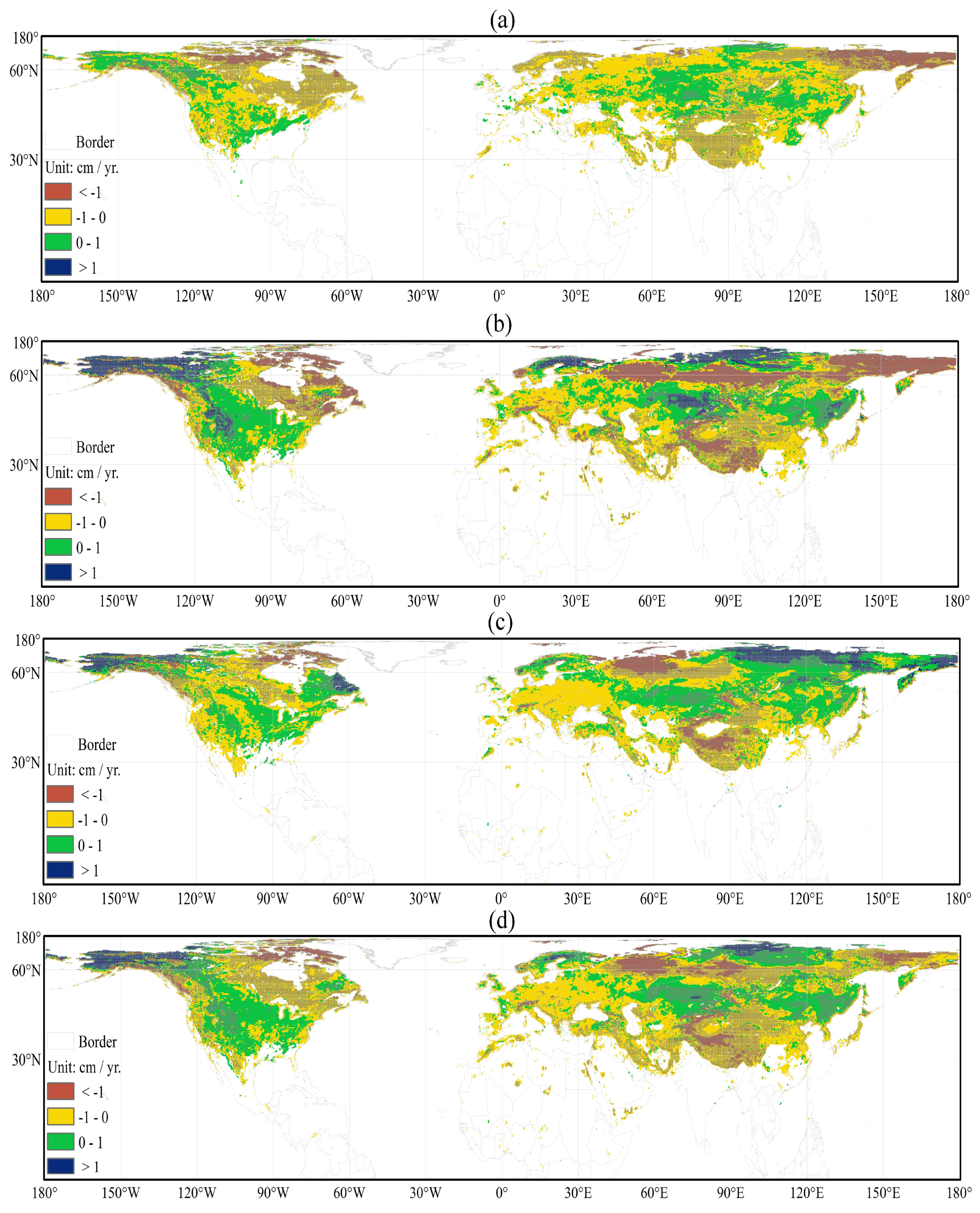
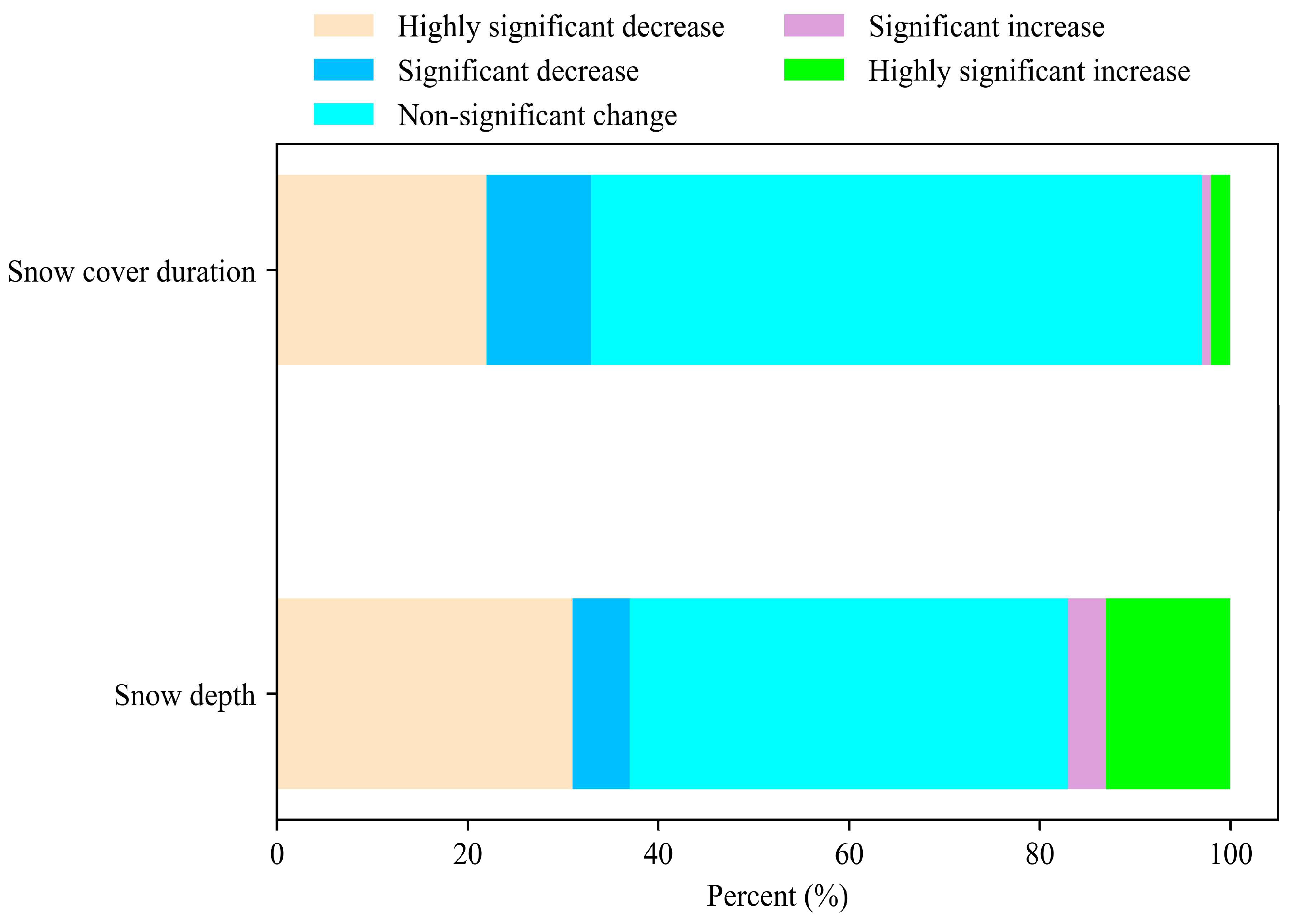

| Value ID | Classification Label | Reclassification Label |
|---|---|---|
| 0 | Water | Water |
| 1 | Evergreen needle leaf forest | Forest |
| 2 | Evergreen broad leaf forest | |
| 3 | Deciduous needle leaf forest | |
| 4 | Deciduous broad leaf forest | |
| 5 | Mixed forest | |
| 6 | Woodland | |
| 7 | Wooded grassland | Prairie (grassland) |
| 10 | Grassland | |
| 8 | Closed shrub land | Shrub |
| 9 | Open shrub land | |
| 11 | Cropland | Bare-land |
| 12 | Bare ground | |
| 13 | Urban and built |
References
- Immerzeel, W.W.; Van Beek, L.P.H.; Bierkens, M.F.P. Climate change will affect the Asian Water Towers. Science 2010, 328, 1382–1385. [Google Scholar] [CrossRef] [PubMed]
- Zhang, T. Influence of the seasonal snow cover on the ground thermal regime: An overview. Rev. Geophys. 2005, 43, 589–590. [Google Scholar] [CrossRef]
- Robinson, D.; Frei, A. Seasonal Variability of Northern Hemisphere Snow Extent Using Visible Satellite Data. Prof. Geogr. 2000, 52, 307–315. [Google Scholar] [CrossRef]
- Tedesco, M.; Derksen, C.; Deems, J.; Foster, J.L. Remote sensing of snow depth and snow water equivalent. Remote Sens. Cryosphere 2014, 73–98. [Google Scholar] [CrossRef]
- Flanner, M.G.; Shell, K.M.; Barlage, M.; Perovich, D.K.; Tschudi, M.A. Radiative forcing and albedo feedback from the Northern Hemisphere cryosphere between 1979 and 2008. Nat. Geosci. 2011, 4, 151–155. [Google Scholar] [CrossRef]
- Zhang, T.; Osterkamp, T.E.; Stamnes, K. Influence of the Depth Hoar Layer of the Seasonal Snow Cover on the Ground Thermal Regime. Water Resour. Res. 1996, 32, 2075–2086. [Google Scholar] [CrossRef]
- Cohen, J.; Furtado, J.C.; A Barlow, M.; Alexeev, V.A.; E Cherry, J. Arctic warming, increasing snow cover and widespread boreal winter cooling. Environ. Res. Lett. 2012, 7, 014007. [Google Scholar] [CrossRef]
- Li, W.; Guo, W.D.; Qiu, B.; Xue, Y.; Hsu, P.-C.; Wei, J. Influence of Tibetan Plateau snow cover on East Asian atmospheric circulation at medium-range time scales. Nat. Commun. 2018, 9, 4243. [Google Scholar] [CrossRef]
- Diffenbaugh, N.S.; Scherer, M.; Ashfaq, M. Response of snow-dependent hydrologic extremes to continued global warming. Nat. Clim. Chang. 2012, 3, 379–384. [Google Scholar] [CrossRef]
- Barnett, T.P.; Adam, J.C.; Lettenmaier, D.P. Potential impacts of a warming climate on water availability in snow-dominated regions. Nature 2005, 438, 303–309. [Google Scholar] [CrossRef]
- Sturm, M. White water: Fifty years of snow research in WRR and the outlook for the future. Water Resour. Res. 2015, 51, 4948–4965. [Google Scholar] [CrossRef]
- Qin, D.; Liu, S.; Li, P. Snow cover distribution, variability, and response to climate change in western China. J. Clim. 2006, 19, 1820–1833. [Google Scholar]
- Brown, R.; Frei, A. Comment on “Evaluation of surface albedo and snow cover in AR4 coupled models” by A. Roesch. J. Geophys. Res. Space Atmos. 2007, 112. [Google Scholar] [CrossRef]
- Foster, J.; Hall, D.K.; Eylander, J.B.; Riggs, G.A.; Nghiem, S.V.; Tedesco, M.; Kim, E.; Montesano, P.M.; Kelly, R.E.J.; Casey, K.A.; et al. A blended global snow product using visible, passive microwave and scatterometer satellite data. Int. J. Remote. Sens. 2011, 32, 1371–1395. [Google Scholar] [CrossRef]
- Chang, A.; Foster, J.; Hall, D. Nimbus-7 SMMR derived global snow cover parameters. Ann. Glaciol. 1987, 9, 39–44. [Google Scholar] [CrossRef]
- Che, T.; Li, X.; Jin, R.; Armstrong, R.; Zhang, T. Snow depth derived from passive microwave remote-sensing data in China. Ann. Glaciol. 2008, 49, 145–154. [Google Scholar] [CrossRef]
- Takala, M.; Luojus, K.; Pulliainen, J.; Derksen, C.; Lemmetyinen, J.; Kärnä, J.-P.; Koskinen, J.; Bojkov, B. Estimating northern hemisphere snow water equivalent for climate research through assimilation of space-borne radiometer data and ground-based measurements. Remote Sens. Environ. 2011, 115, 3517–3529. [Google Scholar] [CrossRef]
- Pulliainen, J.; Luojus, K.; Derksen, C.; Mudryk, L.; Lemmetyinen, J.; Salminen, M.; Ikonen, J.; Takala, M.; Cohen, J.; Smolander, T.; et al. Patterns and trends of Northern Hemisphere snow mass from 1980 to 2018. Nature 2020, 581, 294–298. [Google Scholar] [CrossRef]
- Brown, R.; Derksen, C.; Wang, L. A multi-data set analysis of variability and change in Arctic spring snow cover extent, 1967–2008. J. Geophys. Res. Space Phys. 2010, 115. [Google Scholar] [CrossRef]
- Brown, R.; Robinson, D. Northern Hemisphere spring snow cover variability and change over 1922–2010 including an assessment of uncertainty. Cryosphere 2011, 5, 219–229. [Google Scholar] [CrossRef]
- Dai, L.; Che, T.; Ding, Y.; Hao, X. Evaluation of snow cover and snow depth on the Qinghai–Tibetan Plateau derived from passive microwave remote sensing. Cryosphere 2017, 11, 1933–1948. [Google Scholar] [CrossRef]
- Snauffer, A.; Hsieh, W.W.; Cannon, A. Comparison of gridded snow water equivalent products with in situ measurements in British Columbia, Canada. J. Hydrol. 2016, 541, 714–726. [Google Scholar] [CrossRef]
- Dai, L.; Che, T.; Wang, J.; Zhang, P. Snow depth and snow water equivalent estimation from AMSR-E data based on a priori snow characteristics in Xinjiang, China. Remote. Sens. Environ. 2012, 127, 14–29. [Google Scholar] [CrossRef]
- Xiao, X.; Zhang, T.; Zhong, X.; Shao, W.; Li, X. Support vector regression snow-depth retrieval algorithm using passive microwave remote sensing data. Remote. Sens. Environ. 2018, 210, 48–64. [Google Scholar] [CrossRef]
- Foster, J.; Chang, A.; Hall, D. Comparison of snow mass estimates from a prototype passive microwave snow algorithm, a revised algorithm and a snow depth climatology. Remote. Sens. Environ. 1997, 62, 132–142. [Google Scholar] [CrossRef]
- Kwon, Y.; Yang, Z.-L.; Zhao, L.; Hoar, T.J.; Toure, A.M.; Rodell, M. Estimating Snow Water Storage in North America Using CLM4, DART, and Snow Radiance Data Assimilation. J. Hydrometeorol. 2016, 17, 2853–2874. [Google Scholar] [CrossRef]
- LaRue, F.; Royer, A.; De Sève, D.; Roy, A.; Cosme, E. Assimilation of passive microwave AMSR-2 satellite observations in a snowpack evolution model over northeastern Canada. Hydrol. Earth Syst. Sci. 2018, 22, 5711–5734. [Google Scholar] [CrossRef]
- Charrois, L.; Cosme, E.; Dumont, M.; Lafaysse, M.; Morin, S.; Libois, Q.; Picard, G. On the assimilation of optical reflectances and snow depth observations into a detailed snowpack model. Cryosphere 2016, 10, 1021–1038. [Google Scholar] [CrossRef]
- De Lannoy, G.J.M.; Reichle, R.; Arsenault, K.R.; Houser, P.R.; Kumar, S.; Verhoest, N.E.C.; Pauwels, V.R.N. Multiscale assimilation of Advanced Microwave Scanning Radiometer-EOS snow water equivalent and Moderate Resolution Imaging Spectroradiometer snow cover fraction observations in northern Colorado. Water Resour. Res. 2012, 48. [Google Scholar] [CrossRef]
- Toure, A.M.; Reichle, R.H.; Forman, B.A.; Getirana, A.; De Lannoy, G. Assimilation of MODIS Snow Cover Fraction Observations into the NASA Catchment Land Surface Model. Remote. Sens. 2018, 10, 316. [Google Scholar] [CrossRef]
- Saberi, N.; Kelly, R.; Flemming, M.; Li, Q. Review of snow water equivalent retrieval methods using spaceborne passive microwave radiometry. Int. J. Remote. Sens. 2019, 41, 996–1018. [Google Scholar] [CrossRef]
- Gan, T.Y.; Barry, R.G.; Gizaw, M.; Gobena, A.; Balaji, R. Changes in North American snowpacks for 1979–2007 detected from the snow water equivalent data of SMMR and SSM/I passive microwave and related climatic factors. J. Geophys. Res. Atmos. 2013, 118, 7682–7697. [Google Scholar] [CrossRef]
- Che, T.; Dai, L.; Zheng, X.; Li, X.; Zhao, K. Estimation of snow depth from passive microwave brightness temperature data in forest regions of northeast China. Remote. Sens. Environ. 2016, 183, 334–349. [Google Scholar] [CrossRef]
- Jagt, B.V.; Durand, M.; Margulis, S.A.; Kim, E.J.; Molotch, N.P. The effect of spatial variability on the sensitivity of passive microwave measurements to snow water equivalent. Remote. Sens. Environ. 2013, 136, 163–179. [Google Scholar] [CrossRef]
- Goïta, K.; Walker, A.E.; Goodison, B.E. Algorithm development for the estimation of snow water equivalent in the boreal forest using passive microwave data. Int. J. Remote. Sens. 2003, 24, 1097–1102. [Google Scholar] [CrossRef]
- Derksen, C.; Walker, A.; Goodison, B. Evaluation of passive microwave snow water equivalent retrievals across the boreal forest/tundra transition of western Canada. Remote. Sens. Environ. 2005, 96, 315–327. [Google Scholar] [CrossRef]
- Foster, J.L.; Hall, D.K.; Kelly, R.E.J.; Chiu, L. Seasonal snow extent and snow mass in South America using SMMR and SSM/I passive microwave data (1979–2006). Remote Sens. Environ. 2009, 113, 291–305. [Google Scholar] [CrossRef]
- Durand, M.; Kim, E.J.; Margulis, S.A.; Molotch, N.P. A First-Order Characterization of Errors from Neglecting Stratigraphy in Forward and Inverse Passive Microwave Modeling of Snow. IEEE Geosci. Remote. Sens. Lett. 2011, 8, 730–734. [Google Scholar] [CrossRef]
- Sandells, M.; Essery, R.L.; Rutter, N.; Wake, L.; Leppänen, L.; Lemmetyinen, J. Microstructure representation of snow in coupled snowpack and microwave emission models. Cryosphere 2017, 11, 229–246. [Google Scholar] [CrossRef]
- Roy, A.; Royer, A.; St-Jean-Rondeau, O.; Montpetit, B.; Picard, G.; Mavrovic, A.; Marchand, N.; Langlois, A. Microwave snow emission modeling uncertainties in boreal and subarctic environments. Cryosphere 2016, 10, 623–638. [Google Scholar] [CrossRef]
- Gharaei-Manesh, S.; Fathzadeh, A.; Taghizadeh-Mehrjardi, R. Comparison of artificial neural network and decision tree models in estimating spatial distribution of snow depth in a semi-arid region of Iran. Cold Reg. Sci. Technol. 2016, 122, 26–35. [Google Scholar] [CrossRef]
- Tedesco, M.; Pulliainen, J.; Takala, M.; Hallikainen, M.; Pampaloni, P. Artificial neural network-based techniques for the retrieval of SWE and snow depth from SSM/I data. Remote. Sens. Environ. 2004, 90, 76–85. [Google Scholar] [CrossRef]
- Liang, J.; Liu, X.; Huang, K.; Li, X.; Shi, X.; Chen, Y.; Li, J. Improved snow depth retrieval by integrating microwave brightness temperature and visible/infrared reflectance. Remote. Sens. Environ. 2015, 156, 500–509. [Google Scholar] [CrossRef]
- Forman, B.A.; Reichle, R.H.; Derksen, C. Estimating Passive Microwave Brightness Temperature Over Snow-Covered Land in North America Using a Land Surface Model and an Artificial Neural Network. IEEE Trans. Geosci. Remote. Sens. 2013, 52, 235–248. [Google Scholar] [CrossRef]
- Xue, Y.; Forman, B.A. Comparison of passive microwave brightness temperature prediction sensitivities over snow-covered land in North America using machine learning algorithms and the Advanced Microwave Scanning Radiometer. Remote. Sens. Environ. 2015, 170, 153–165. [Google Scholar] [CrossRef]
- Rupp, D.E.; Mote, P.W.; Bindoff, N.; Stott, P.A.; Robinson, D.A. Detection and Attribution of Observed Changes in Northern Hemisphere Spring Snow Cover. J. Clim. 2013, 26, 6904–6914. [Google Scholar] [CrossRef]
- Derksen, C.; Brown, R. Spring snow cover extent reductions in the 2008-2012 period exceeding climate model projections. Geophys. Res. Lett. 2012, 39. [Google Scholar] [CrossRef]
- Huang, X.; Deng, J.; Ma, X.; Wang, Y.; Feng, Q.; Hao, X.; Liang, T. Spatiotemporal dynamics of snow cover based on multi-source remote sensing data in China. Cryosphere 2016, 10, 2453–2463. [Google Scholar] [CrossRef]
- Dyer, J.L.; Mote, T.L. Spatial variability and trends in observed snow depth over North America. Geophys. Res. Lett. 2006, 33. [Google Scholar] [CrossRef]
- Huang, X.; Deng, J.; Wang, W.; Feng, Q.; Liang, T. Impact of climate and elevation on snow cover using integrated remote sensing snow products in Tibetan Plateau. Remote. Sens. Environ. 2017, 190, 274–288. [Google Scholar] [CrossRef]
- Hori, M.; Sugiura, K.; Kobayashi, K.; Aoki, T.; Tanikawa, T.; Kuchiki, K.; Niwano, M.; Enomoto, H. A 38-year (1978–2015) Northern Hemisphere daily snow cover extent product derived using consistent objective criteria from satellite-borne optical sensors. Remote Sens. Environ. 2017, 191, 402–418. [Google Scholar] [CrossRef]
- Barrett, B.S.; Henderson, G.R.; Werling, J.S. The Influence of the MJO on the Intraseasonal Variability of Northern Hemisphere Spring Snow Depth. J. Clim. 2015, 28, 7250–7262. [Google Scholar] [CrossRef]
- Wegmann, M.; Orsolini, Y.; Dutra, E.; Bulygina, O.; Sterin, A.; Brönnimann, S. Eurasian snow depth in long-term climate reanalyses. Cryosphere 2017, 11, 923–935. [Google Scholar] [CrossRef]
- Brodzik, M.J.; Knowles, K. EASE-Grid: A Versatile Set of Equal-Area Projections and Grids; National Center for Geographic Information & Analysis: Buffalo, NY, USA, 2002. [Google Scholar]
- Armstrong, R.L.; Knowles, K.W.; Brodzik, M.J.; Hardman, M.A. DMSP SSM/I Pathfinder Daily EASE-Grid Brightness Temperatures; National Snow and Ice Data Center: Boulder, CO, USA, 2008. [Google Scholar]
- Wentz, F.J. SSM/I version-7 calibration report. Remote Sens. Syst. Tech. Rep. 2013, 11012, 1613–1627. [Google Scholar]
- Armstrong, R.; Brodzik, M. An earth-gridded SSM/I data set for cryospheric studies and global change monitoring. Adv. Space Res. 1995, 16, 155–163. [Google Scholar] [CrossRef]
- Dai, L.; Che, T.; Ding, Y. Inter-Calibrating SMMR, SSM/I and SSMI/S Data to Improve the Consistency of Snow-Depth Products in China. Remote. Sens. 2015, 7, 7212–7230. [Google Scholar] [CrossRef]
- Xu, X.; Liu, X.; Li, X.; Xin, Q.; Chen, Y.; Shi, Q.; Ai, B. Global snow cover estimation with Microwave Brightness Temperature measurements and one-class in situ observations. Remote. Sens. Environ. 2016, 182, 227–251. [Google Scholar] [CrossRef]
- Zhong, X. Spatiotemporal variability of snow cover and the relationship between snow and climate change across the Eurasian Continent. In Cold and Arid Regions Environmental and Engineering Research Institute; CAS: Lanzhou, China, 2014. [Google Scholar]
- Amante, C.; Eakins, B.W. ETOPO1 1 arc-Minute Global Relief Model: Procedures, Data Sources and Analysis; US Department of Commerce, National Oceanic and Atmospheric Administration, National Environmental Satellite, Data, and Information Service, National Geophysical Data Center, Marine Geology and Geophysics Division: Colorado, CO, USA, 2009.
- Friedl, M.A.; Sulla-Menashe, D. Note to Users of MODIS Land Cover (MCD12Q1) Products. 2011. Available online: https://lpdaac.usgs.gov/products/mcd12q1v006/ (accessed on 2 March 2014).
- Friedl, M.; Sulla-Menashe, D.; Tan, B.; Schneider, A.; Ramankutty, N.; Sibley, A.; Huang, X. MODIS Collection 5 global land cover: Algorithm refinements and characterization of new datasets. Remote. Sens. Environ. 2010, 114, 168–182. [Google Scholar] [CrossRef]
- Hansen, M.C.; DeFries, R.S.; Townshend, J.R.G.; Sohlberg, R. Global land cover classification at 1 km spatial resolution using a classification tree approach. Int. J. Remote. Sens. 2000, 21, 1331–1364. [Google Scholar] [CrossRef]
- Hancock, S.; Baxter, R.; Evans, J.; Huntley, B. Evaluating global snow water equivalent products for testing land surface models. Remote. Sens. Environ. 2013, 128, 107–117. [Google Scholar] [CrossRef]
- Mudryk, L.R.; Derksen, C.; Kushner, P.J.; Brown, R. Characterization of Northern Hemisphere Snow Water Equivalent Datasets, 1981–2010. J. Clim. 2015, 28, 8037–8051. [Google Scholar] [CrossRef]
- Pulliainen, J. Mapping of snow water equivalent and snow depth in boreal and sub-arctic zones by assimilating space-borne microwave radiometer data and ground-based observations. Remote. Sens. Environ. 2006, 101, 257–269. [Google Scholar] [CrossRef]
- Sturm, M.; Taras, B.; Liston, G.E.; Derksen, C.; Jonas, T.; Lea, J. Estimating Snow Water Equivalent Using Snow Depth Data and Climate Classes. J. Hydrometeorol. 2010, 11, 1380–1394. [Google Scholar] [CrossRef]
- Balsamo, G.; Albergel, C.; Beljaars, A.; Boussetta, S.; Brun, E.; Cloke, H.; Dee, D.; Dutra, E.; Muñoz-Sabater, J.; Pappenberger, F.; et al. ERA-Interim/Land: A global land surface reanalysis dataset. in European Geosciences Union General Assembly. Hydrol. Earth Syst. Sci. 2015, 19, 389–407. [Google Scholar] [CrossRef]
- Dutra, E.; Balsamo, G.; Viterbo, P.; Miranda, P.M.A.; Beljaars, A.; Schär, C.; Elder, K. An Improved Snow Scheme for the ECMWF Land Surface Model: Description and Offline Validation. J. Hydrometeorol. 2010, 11, 899–916. [Google Scholar] [CrossRef]
- Forman, B.A.; Reichle, R.H. Using a Support Vector Machine and a Land Surface Model to Estimate Large-Scale Passive Microwave Brightness Temperatures Over Snow-Covered Land in North America. IEEE J. Sel. Top. Appl. Earth Obs. Remote. Sens. 2014, 8, 4431–4441. [Google Scholar] [CrossRef]
- Grippa, M.; Mognard, N.; Le Toan, T.; Josberger, E. Siberia snow depth climatology derived from SSM/I data using a combined dynamic and static algorithm. Remote. Sens. Environ. 2004, 93, 30–41. [Google Scholar] [CrossRef]
- Smith, T.; Bookhagen, B. Assessing uncertainty and sensor biases in passive microwave data across High Mountain Asia. Remote. Sens. Environ. 2016, 181, 174–185. [Google Scholar] [CrossRef]
- Dong, J.; Ek, M.; Hall, D.; Peters-Lidard, C.; Cosgrove, B.; Miller, J.; Riggs, G.; Xia, Y. Using Air Temperature to Quantitatively Predict the MODIS Fractional Snow Cover Retrieval Errors over the Continental United States. J. Hydrometeorol. 2014, 15, 551–562. [Google Scholar] [CrossRef]
- Grody, N.; Basist, A.N. Global identification of snowcover using SSM/I measurements. IEEE Trans. Geosci. Remote. Sens. 1996, 34, 237–249. [Google Scholar] [CrossRef]
- Bilello, M.A. Regional and Seasonal Variations in Snow-Cover Density in the U.S.S.R.; Cold Regions Research and Engineering Lab: Hanover, NH, USA, 1984. [Google Scholar]
- Zhong, X.; Zhang, T.; Wang, K. Snow density climatology across the former USSR. Cryosphere 2014, 8, 785–799. [Google Scholar] [CrossRef]
- Wang, X.; Xie, H.; Liang, T. Evaluation of MODIS snow cover and cloud mask and its application in Northern Xinjiang, China. Remote. Sens. Environ. 2008, 112, 1497–1513. [Google Scholar] [CrossRef]
- Wang, C.; Li, D. Spatial-temporal variations of snow cover days and the maximum depth of snow cover in China during recent 50 years. J. Glaciol. Geocryol. 2012, 34, 247–256. [Google Scholar]
- Wu, X.; Che, T.; Li, X.; Wang, N.; Yang, X. Slower Snowmelt in Spring Along with Climate Warming Across the Northern Hemisphere. Geophys. Res. Lett. 2018, 45, 12331–12339. [Google Scholar] [CrossRef]
- Bulygina, O.N.; Groisman, P.; Razuvaev, V.N.; Korshunova, N.N. Changes in snow cover characteristics over Northern Eurasia since 1966. Environ. Res. Lett. 2011, 6, 045204. [Google Scholar] [CrossRef]
- Brown, R.; Fang, B.; Mudryk, L. Update of Canadian Historical Snow Survey Data and Analysis of Snow Water Equivalent Trends, 1967–2016. Atmos. Ocean 2019, 57, 149–156. [Google Scholar] [CrossRef]
- Zhong, X.; Zhang, T.; Kang, S.; Wang, K.; Zheng, L.; Hu, Y.; Wang, H. Spatiotemporal variability of snow depth across the Eurasian continent from 1966 to 2012. Cryosphere 2018, 12, 227–245. [Google Scholar] [CrossRef]
- Tedesco, M.; Narvekar, P.S. Assessment of the NASA AMSR-E SWE Product. IEEE J. Sel. Top. Appl. Earth Obs. Remote. Sens. 2010, 3, 141–159. [Google Scholar] [CrossRef]
- Wang, Y.; Huang, X.; Liang, H.; Sun, Y.; Feng, Q.; Liang, T. Tracking Snow Variations in the Northern Hemisphere Using Multi-Source Remote Sensing Data (2000–2015). Remote Sens. 2018, 10, 136. [Google Scholar] [CrossRef]
- Liu, X.; Jiang, L.; Wu, S.; Hao, S.; Wang, G.; Yang, J. Assessment of Methods for Passive Microwave Snow Cover Mapping Using FY-3C/MWRI Data in China. Remote. Sens. 2018, 10, 524. [Google Scholar] [CrossRef]
- Hall, D.K.; Kelly, R.E.J.; Riggs, G.A.; Chang, A.T.C.; Foster, J. Assessment of the relative accuracy of hemispheric-scale snow-cover maps. Ann. Glaciol. 2002, 34, 24–30. [Google Scholar] [CrossRef]
- Tsutsui, H.; Koike, T. Development of Snow Retrieval Algorithm Using AMSR-E for the BJ Ground-Based Station on Seasonally Frozen Ground at Low Altitude on the Tibetan Plateau. J. Meteorol. Soc. Jpn. 2012, 90, 99–112. [Google Scholar] [CrossRef]
- Singh, P.R.; Gan, T.Y. Retrieval of Snow Water Equivalent Using Passive Microwave Brightness Temperature Data. Remote. Sens. Environ. 2000, 74, 275–286. [Google Scholar] [CrossRef]
- Xue, Y.; Forman, B.A.; Reichle, R.H. Estimating snow mass in North America through assimilation of AMSR-E brightness temperature observations using the Catchment land surface model and support vector machines. Water Resour. Res. 2018, 54, 6488–6509. [Google Scholar] [CrossRef] [PubMed]
- LaRue, F.; Royer, A.; De Seve, D.; Langlois, A.; Roy, A.; Brucker, L. Validation of GlobSnow-2 snow water equivalent over Eastern Canada. Remote. Sens. Environ. 2017, 194, 264–277. [Google Scholar] [CrossRef]
- Tennant, C.; Harpold, A.A.; Lohse, K.A.; Godsey, S.E.; Crosby, B.T.; Larsen, L.; Brooks, P.D.; Van Kirk, R.W.; Glenn, N.F. Regional sensitivities of seasonal snowpack to elevation, aspect, and vegetation cover in western North America. Water Resour. Res. 2017, 53, 6908–6926. [Google Scholar] [CrossRef]
- Musselman, K.N.; Clark, M.P.; Liu, C.; Ikeda, K.; Rasmussen, R. Slower snowmelt in a warmer world. Nat. Clim. Chang. 2017, 7, 214–219. [Google Scholar] [CrossRef]
- Brown, R.; Mote, P.W. The Response of Northern Hemisphere Snow Cover to a Changing Climate*. J. Clim. 2009, 22, 2124–2145. [Google Scholar] [CrossRef]
- Zeng, X.; Broxton, P.D.; Dawson, N. Snowpack Change from 1982 to 2016 Over Conterminous United States. Geophys. Res. Lett. 2018, 45, 12940–12947. [Google Scholar] [CrossRef]

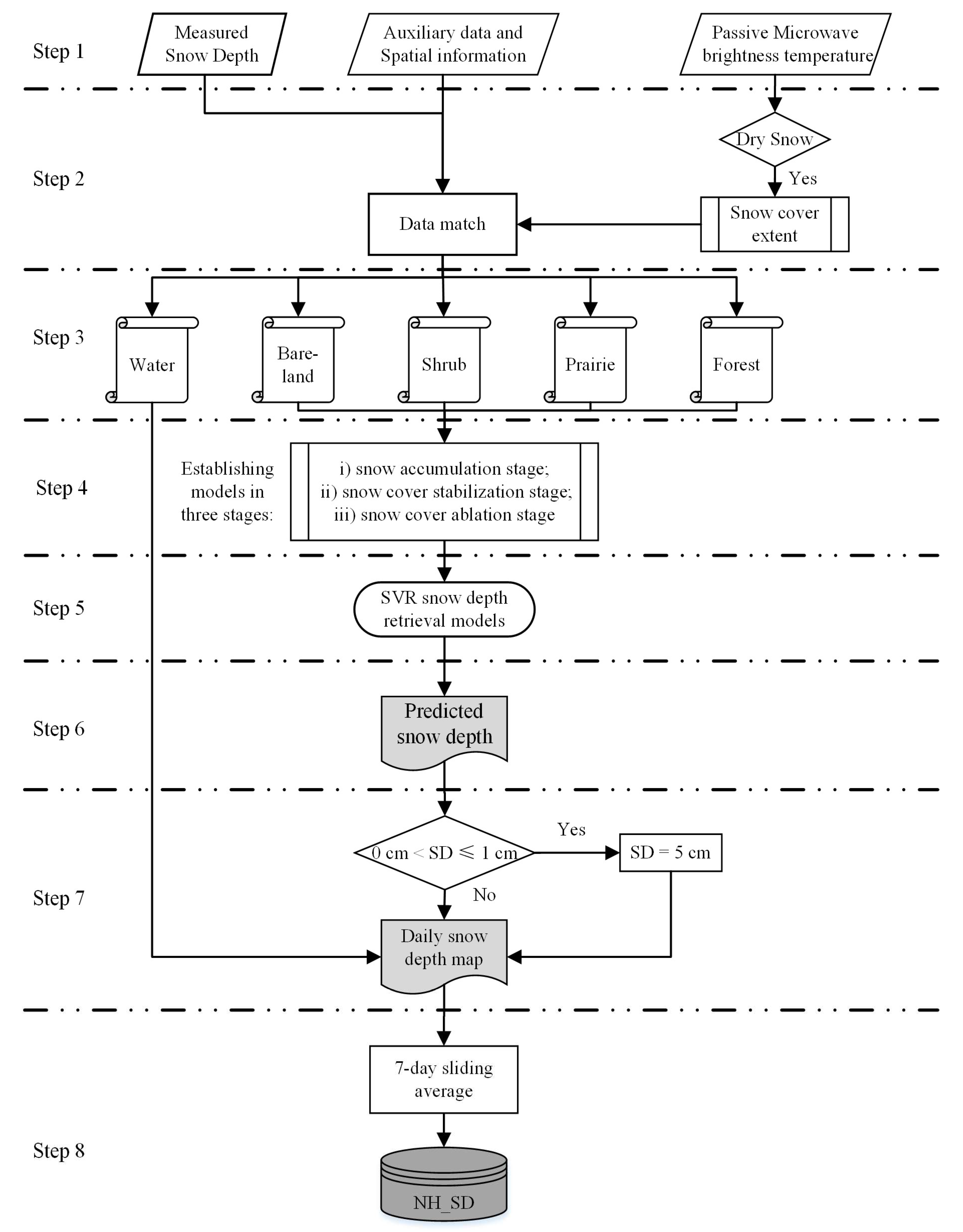
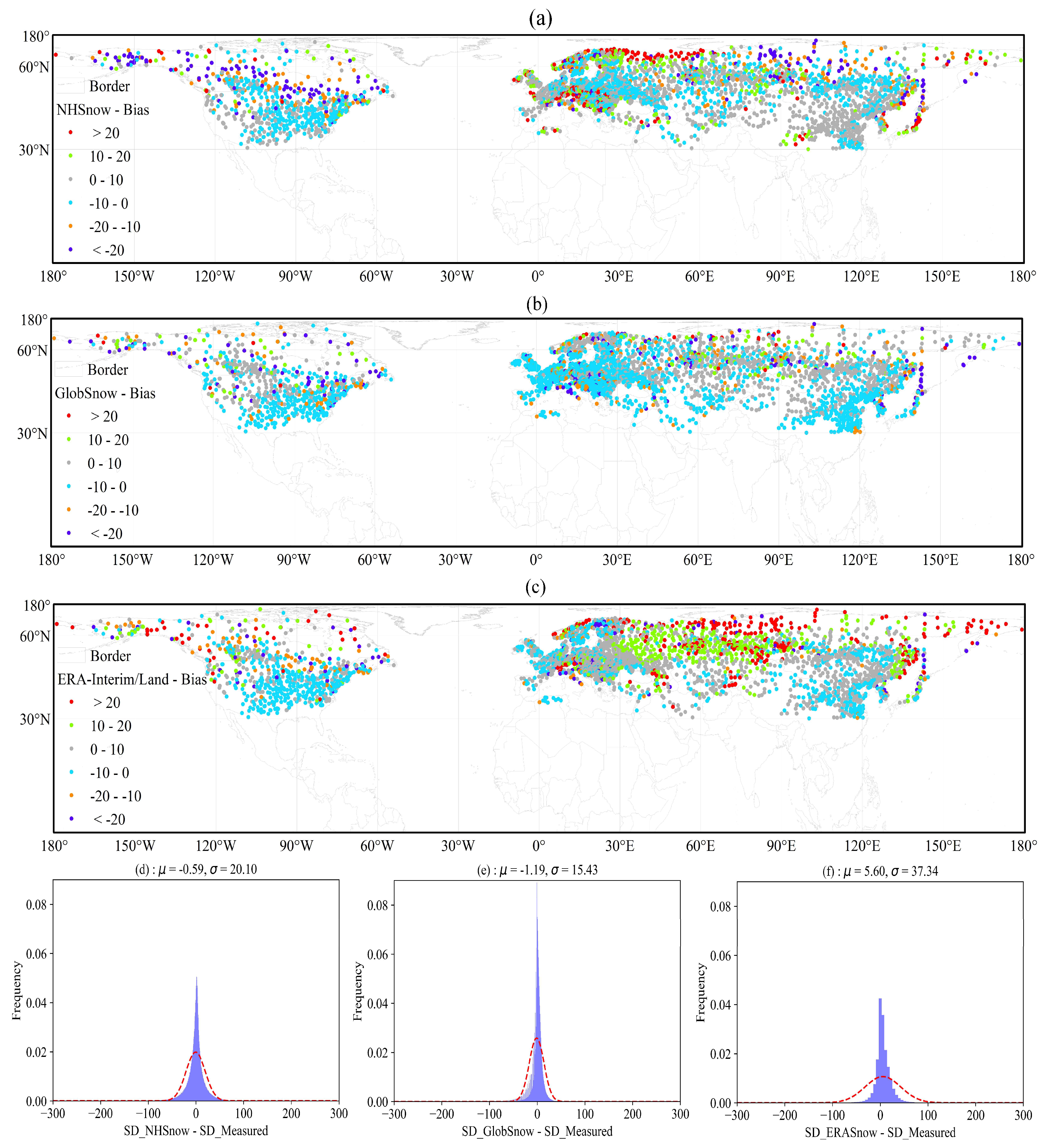
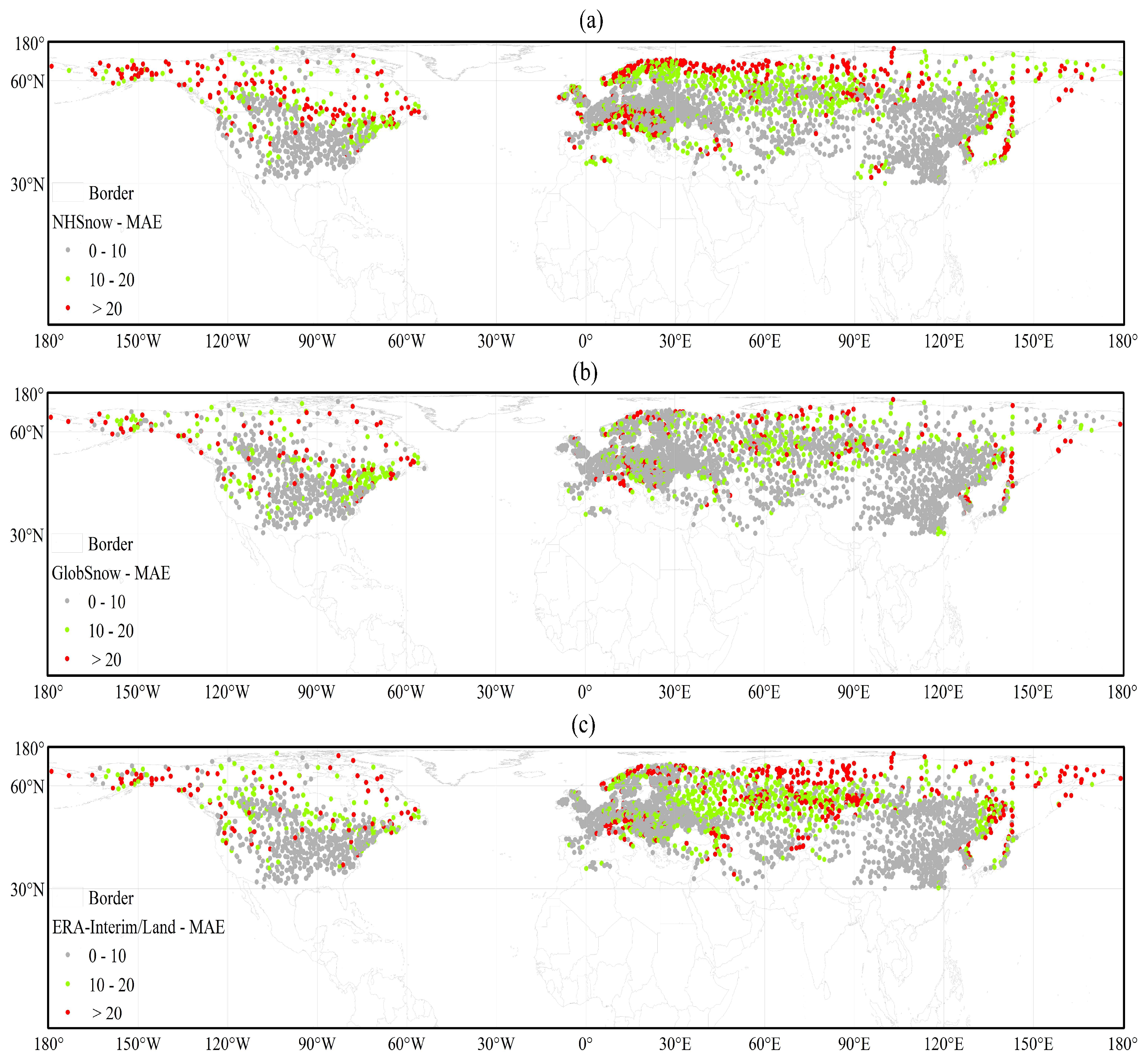

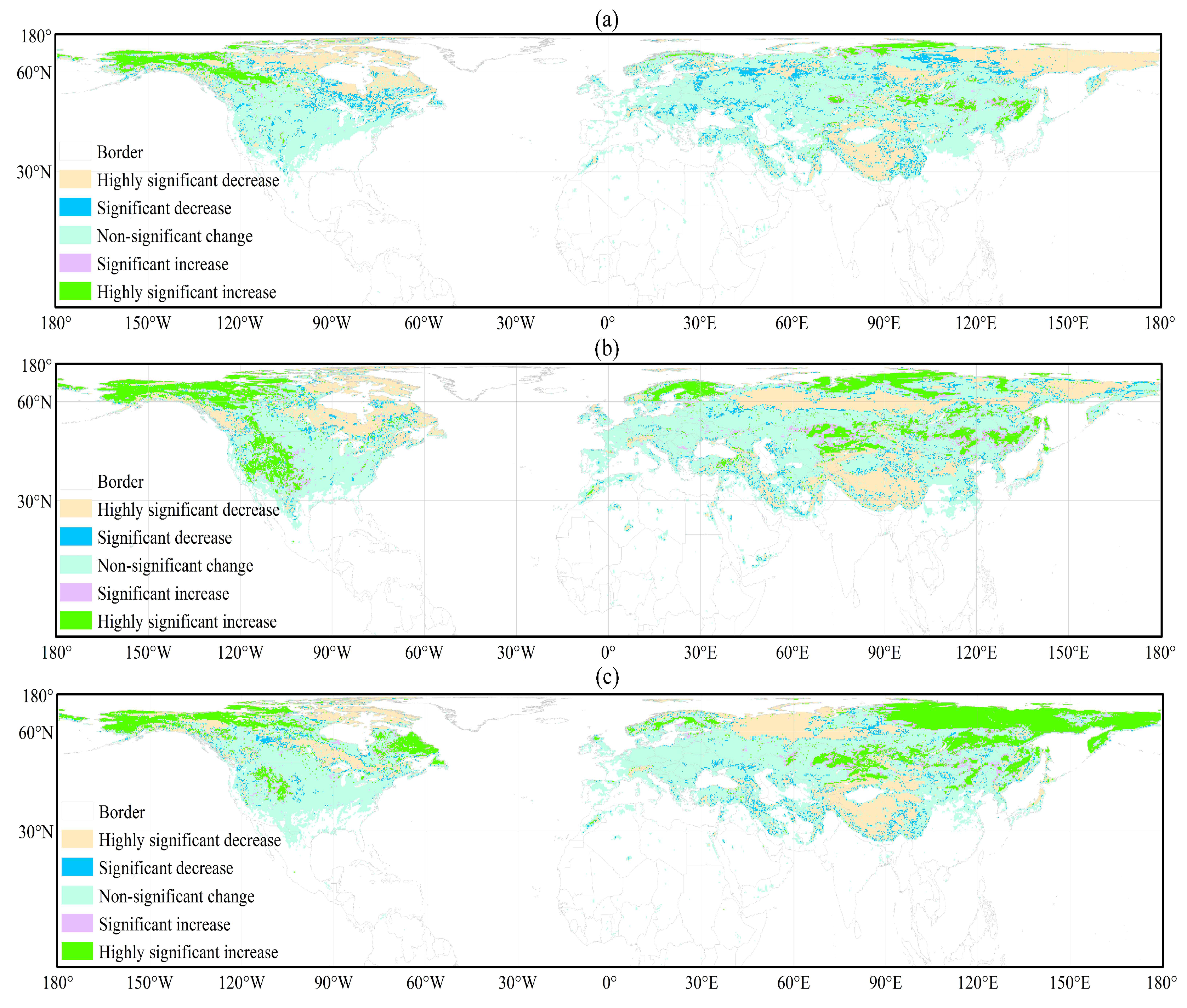
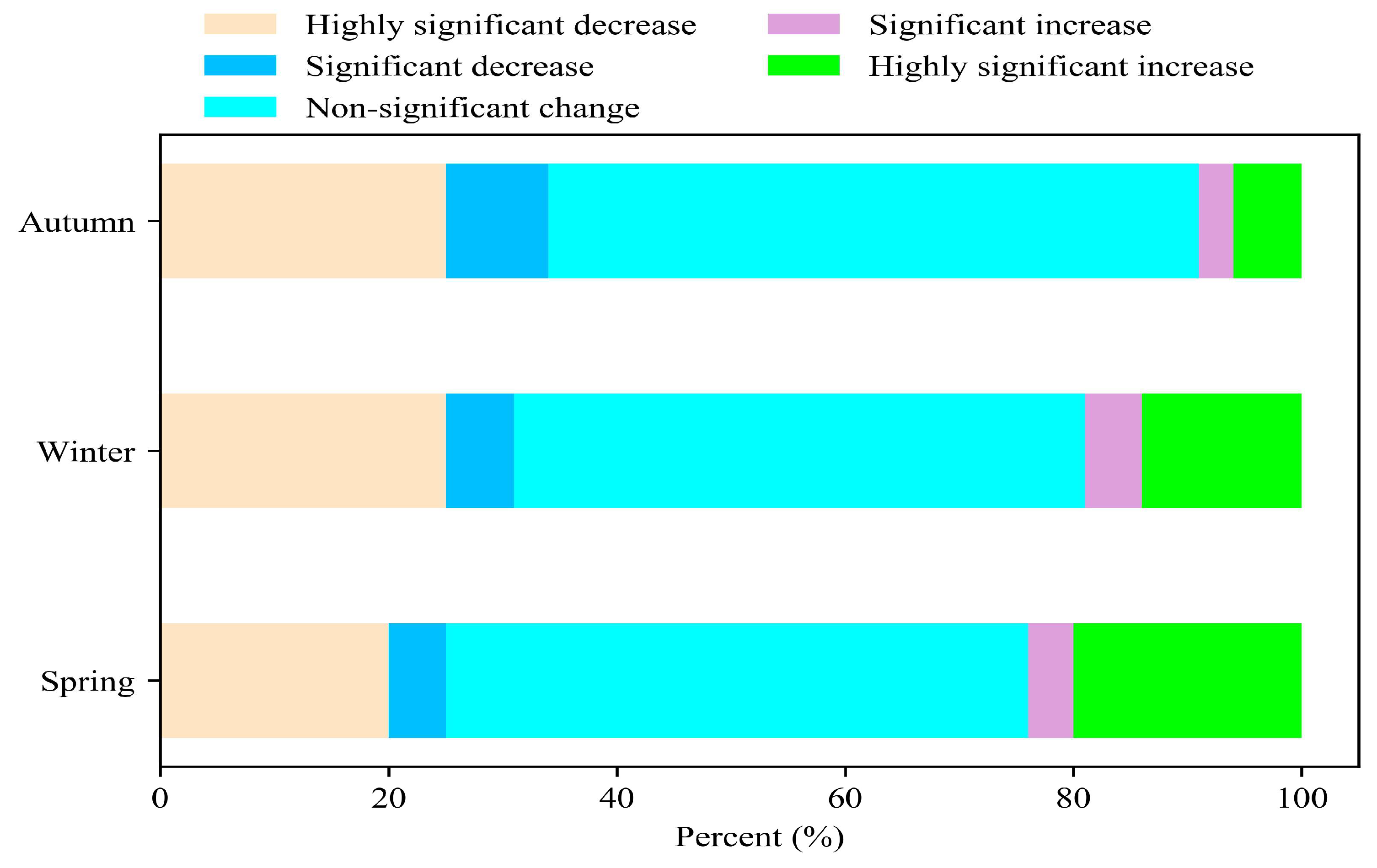
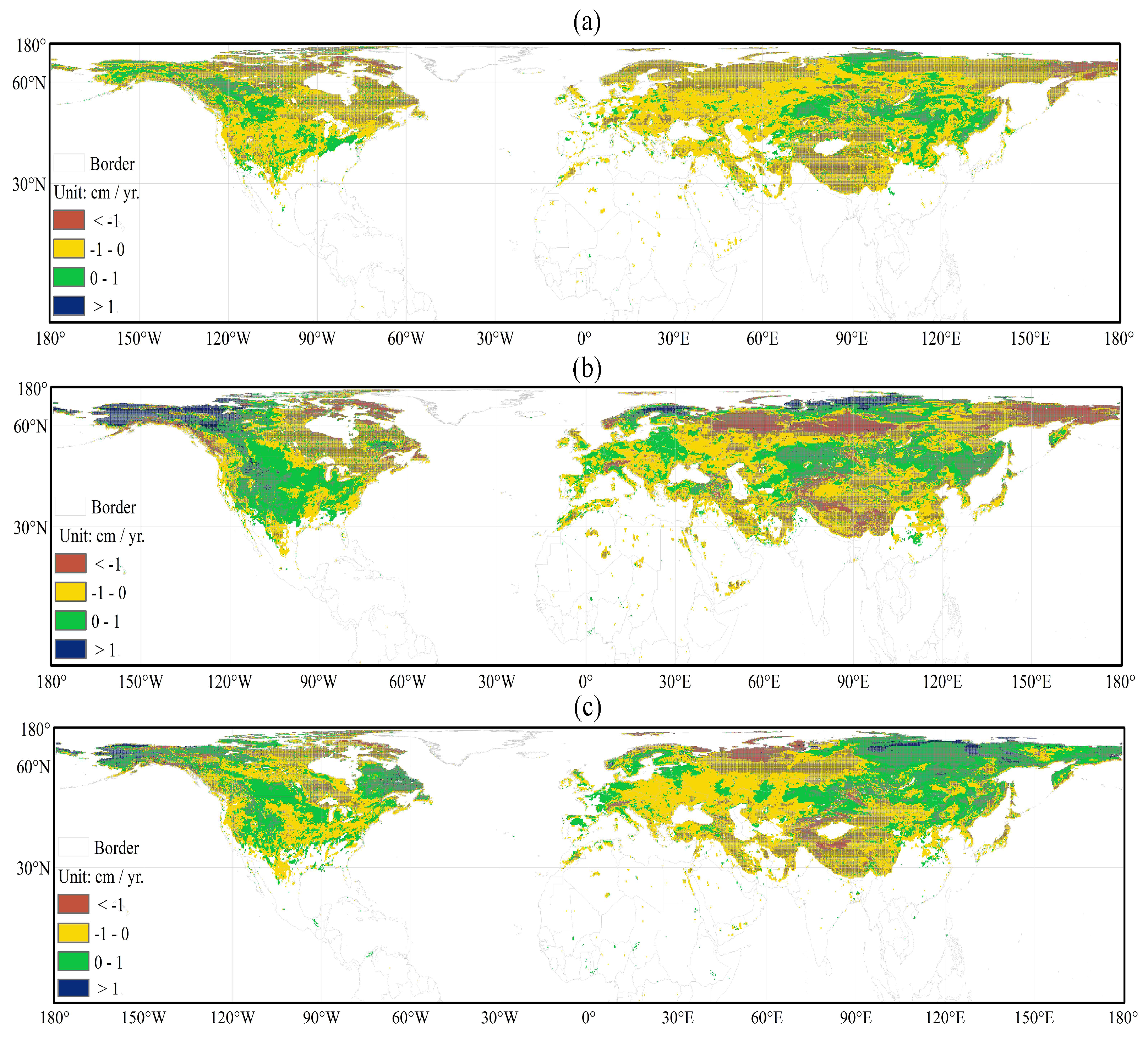

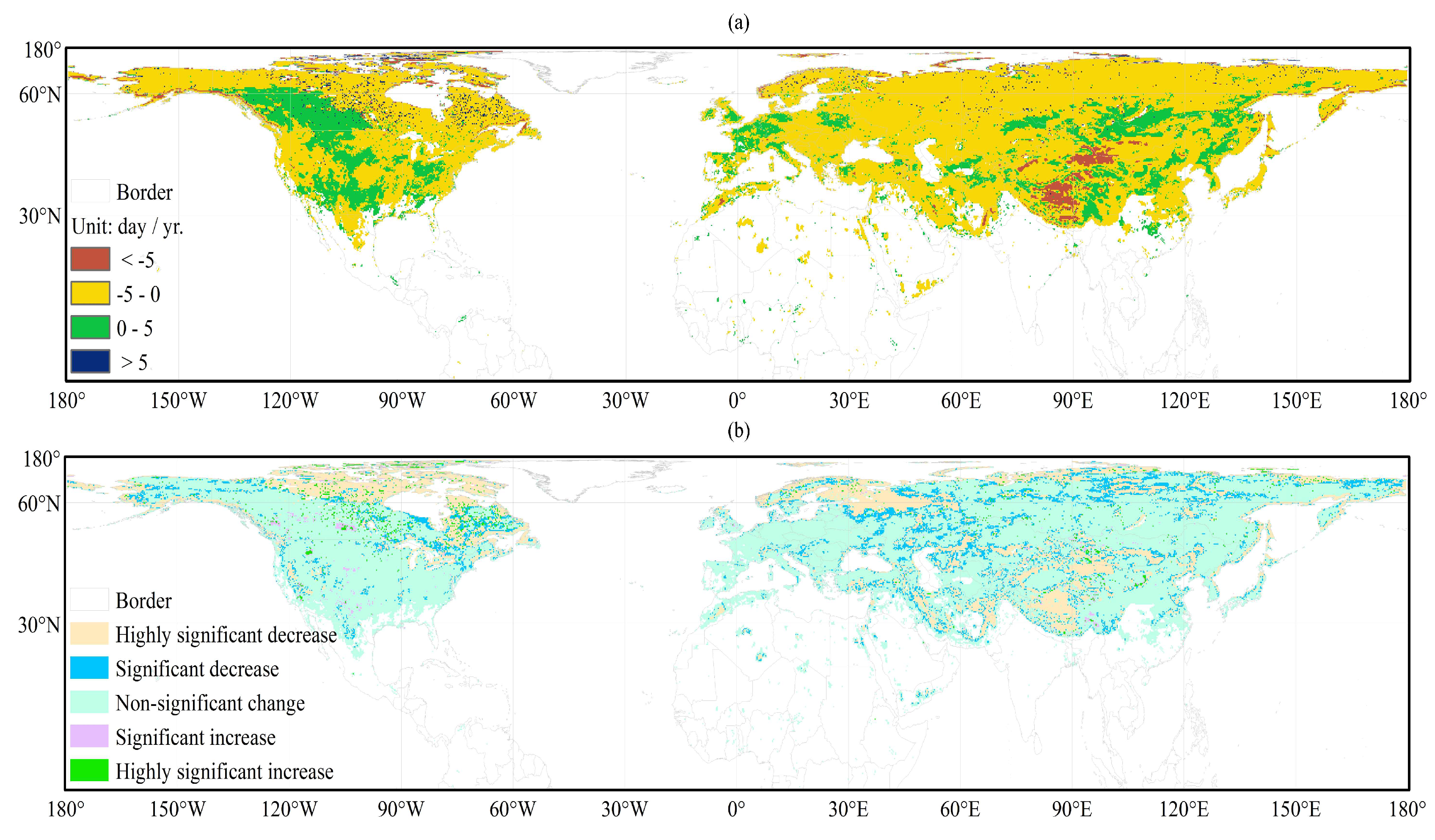

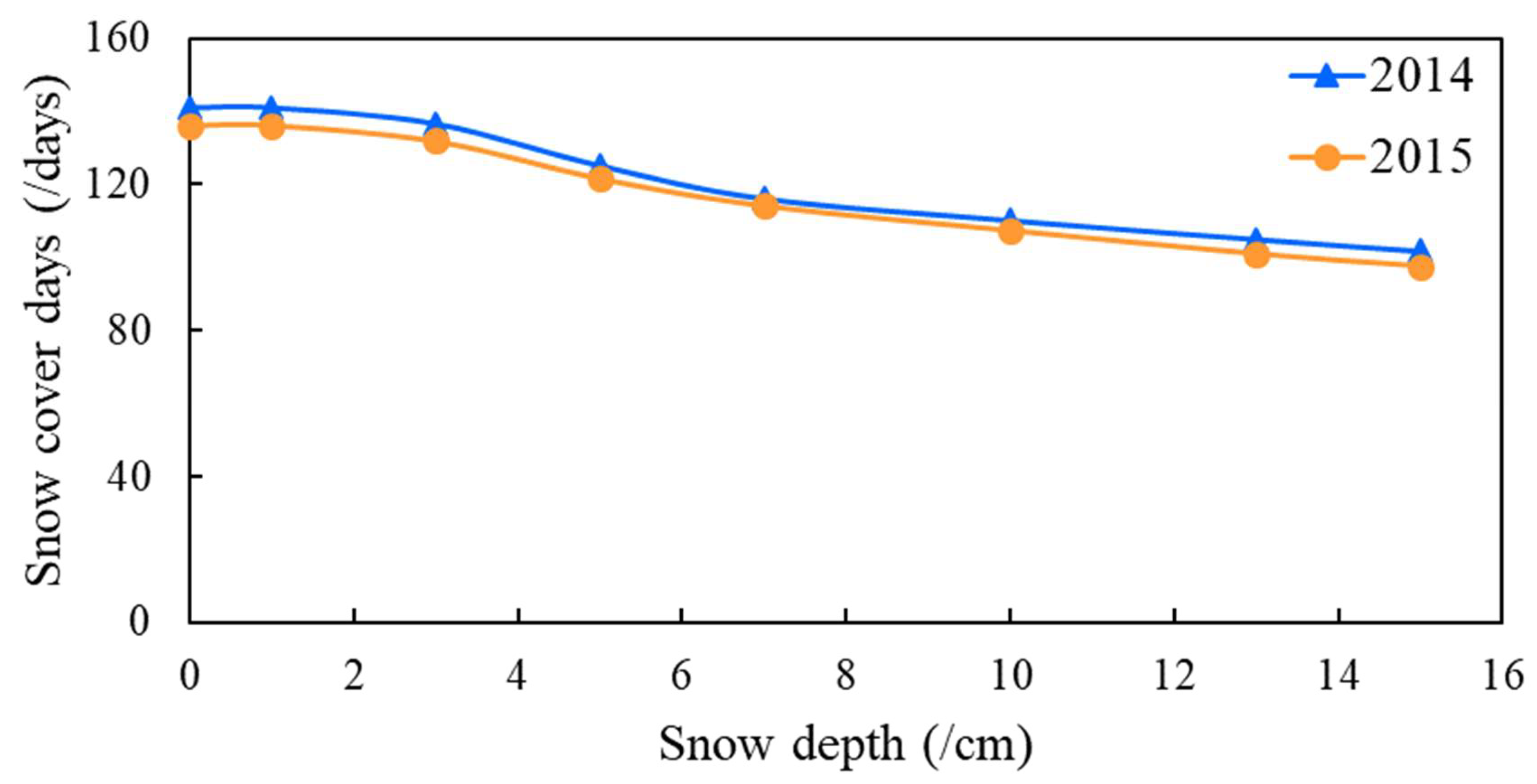
| Satellite | SSM/I | SSMIS | |
|---|---|---|---|
| Platform | F 11 | F 13 | F 17 |
| Temporal coverage | 1991.12–1995.5 | 1995.5–2008.6 | 2006.12– |
| Channels (GHz) | 19 H, V; 22 V; 37 H, V; 85 H, V | 19 H, V; 22 V; 37 H, V; 91 H, V | |
| Group ID | Filter Rules |
|---|---|
| Group 2 | If Else |
| Group 3 | If Else |
| Group 1 | If or Else |
| Variation Rate | P Value | Variation Level |
|---|---|---|
| Rate < 0 | P ≤ 0.01 | Highly significant decrease |
| Rate < 0 | 0.01 < P ≤ 0.05 | Significant decrease |
| - | P > 0.05 | Non-significant change |
| Rate > 0 | 0.01 < P ≤ 0.05 | Significant increase |
| Rate > 0 | P ≤ 0.01 | Highly significant increase |
| Datasets | Bias | MAE | RMSE |
|---|---|---|---|
| NHSnow | −0.59 | 15.98 | 20.11 |
| GlobSnow | −1.19 | 15.12 | 15.48 |
| ERA-Interim/Land | 5.60 | 18.72 | 37.77 |
| Season | 1992–2016 (Mean ± 1 Std.) | 1992–2001 (Mean ± 1 Std.) | 2002–2016 (Mean ± 1 Std.) |
|---|---|---|---|
| Autumn | −0.08 ± 0.11 | −0.01 ± 0.19 | −0.15 ± 0.22 |
| Winter | −0.11 ± 0.40 | 0.06 ± 0.62 | −0.22 ± 0.75 |
| Spring | −0.04 ± 0.25 | 0.02 ± 0.51 | −0.07 ± 0.41 |
| Year | −0.06 ± 0.20 | 0.02 ± 0.35 | −0.11 ± 0.34 |
© 2020 by the authors. Licensee MDPI, Basel, Switzerland. This article is an open access article distributed under the terms and conditions of the Creative Commons Attribution (CC BY) license (http://creativecommons.org/licenses/by/4.0/).
Share and Cite
Xiao, X.; Zhang, T.; Zhong, X.; Li, X. Spatiotemporal Variation of Snow Depth in the Northern Hemisphere from 1992 to 2016. Remote Sens. 2020, 12, 2728. https://doi.org/10.3390/rs12172728
Xiao X, Zhang T, Zhong X, Li X. Spatiotemporal Variation of Snow Depth in the Northern Hemisphere from 1992 to 2016. Remote Sensing. 2020; 12(17):2728. https://doi.org/10.3390/rs12172728
Chicago/Turabian StyleXiao, Xiongxin, Tingjun Zhang, Xinyue Zhong, and Xiaodong Li. 2020. "Spatiotemporal Variation of Snow Depth in the Northern Hemisphere from 1992 to 2016" Remote Sensing 12, no. 17: 2728. https://doi.org/10.3390/rs12172728
APA StyleXiao, X., Zhang, T., Zhong, X., & Li, X. (2020). Spatiotemporal Variation of Snow Depth in the Northern Hemisphere from 1992 to 2016. Remote Sensing, 12(17), 2728. https://doi.org/10.3390/rs12172728





